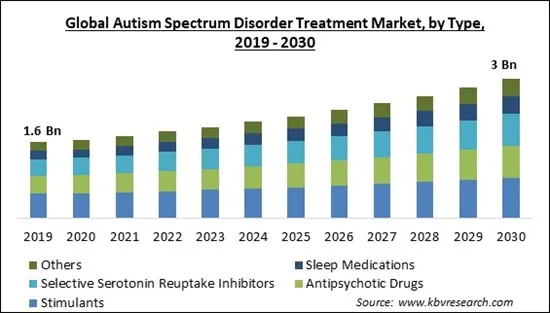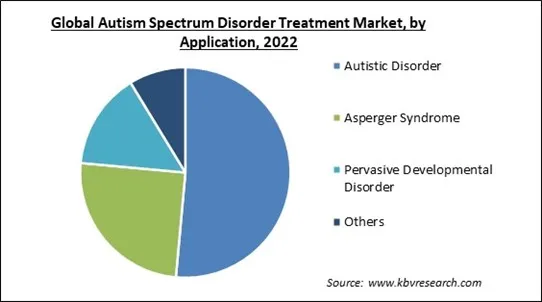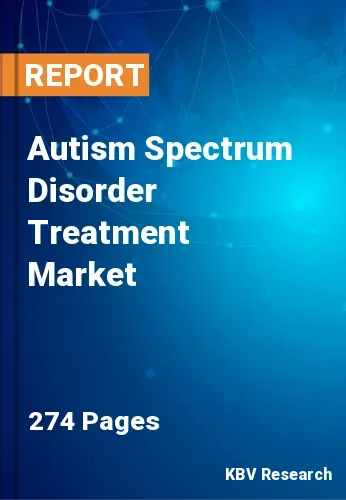The Global Autism Spectrum Disorder Treatment Market size is expected to reach $3.0 billion by 2030, rising at a market growth of 6.2% CAGR during the forecast period.
The patient, the caregivers, the family, and the community are all impacted by autism spectrum disorder, as it is a chronic condition. Hence, the Autistic Disorder segment captured $958.6 million revenue of the market in 2022. Every adult or child with autism faces a unique mix of difficulties, and many persons diagnosed also have other medical disorders, such as gastrointestinal (GI) distress. On the basis of this concept, numerous therapies were created. At that point, enzyme replacement therapy was established, and it has since become one of the most significant trends in the treatment of autism spectrum disorders. Some of the factors impacting the market are the rising number of initiatives by the government to raise awareness, growing prevalence of autism spectrum disorder, and slow approval rate and low availability of drugs.

The expansion of the market is being fueled by a growing array of government initiatives, such as the establishment of various foundations and the approval of different financing for autism awareness in multiple nations. Some international initiatives and organizations focus on autism-related issues, including advocacy, research, awareness, and support. International Society for Autism Research (INSAR) hosts an annual conference that brings together researchers, clinicians, and advocates worldwide. Thus, an expanding number of programs for individuals with the illness might eventually result in early symptom diagnosis and accelerate market expansion. Moreover, the market is expanding favorably as the prevalence of ASD rises, which has increased the demand for clinical research for efficient treatment. This can improve outcomes as well as help in treating certain illnesses more accurately. According to the National Library of Medicine, there were approximately 28.3 million autistic people in the world in 2019. Due to the rising need for potent medications, it is also projected that the rising prevalence rate in emerging nations would be one of the main drivers of market expansion. Therefore, the increasing prevalence of ASD will support the market's growth prospects throughout the forecast period.
Furthermore, during the early phases of the COVID-19 pandemic, many healthcare businesses were forced to close their doors, which slowed down production. The pandemic disrupted many in-person services, including therapy sessions, speech therapy, and occupational therapy. However, telehealth and teletherapy options became more widely adopted to address the disruption in services. Many therapists and healthcare providers began offering remote consultations and therapy sessions. The rapid acceptance of telehealth systems by the patient's caregivers/family was prompted by the rising anxiety levels in ASD patients and the possibility of contracting COVID-19, as these patients come under vulnerable categories. Additionally, the market expanded during COVID-19 due to the increased use of online sources to buy drugs for autism.
However, despite the growing demand for effective medications and clinical studies for autism, no medication has yet been able to completely alleviate any of the main symptoms of autism spectrum disease. despite numerous attempts, there hasn't been any concrete proof in the modern-day era of targeted treatments demonstrating any drug's efficacy for treating the condition's primary symptoms. The development of treatments is consequently made more difficult, which lowers the demand for therapies for people with autism spectrum disorders. Therefore, the absence of approved medications to treat patients may hinder the market's expansion.
On the basis of application, the market is classified into autistic disorder, asperger syndrome, pervasive developmental disorder, and others. The asperger syndrome segment recorded a significant revenue share in the market in 2022. Individuals with Asperger's syndrome typically have difficulty with social interactions. They may struggle with understanding nonverbal cues such as facial expressions and body language, which can make it challenging to engage in typical social exchanges. A common trait among individuals with Asperger's syndrome is limited eye contact during conversations. They may not maintain specific levels of eye contact during social interactions. People with Asperger's may find it challenging to engage in pretend play or imagine scenarios that differ from their experiences.

Based on type, the market is characterized into antipsychotic drugs, selective serotonin reuptake inhibitors, stimulants, sleep medications, and others. The stimulants segment garnered the highest revenue share in the market in 2022. The segment's expansion can be attributed to patients' increasing access to and availability of medications. The U.S. FDA has licensed several stimulants for use in the treatment of autistic people, including Dexedrine, Focalin, Vyvanse, Adderall, and Ritalin. When adequately supplied to patients, these medications reduce their symptoms by 80%. The high efficacy of the stimulants may, therefore, draw in new target customers and diversify the source of income.
By distribution channel, the market is divided into hospital pharmacy, retail pharmacy, and online pharmacy. The retail pharmacy segment witnessed the maximum revenue share in the market in 2022. Drugs like anticonvulsants, tricyclic antidepressants, stimulants, SSRIs, and anxiety meds are widely accessible at retail pharmacies. This widespread availability of different medications is responsible for the growth of the market segment. According to a June 2021 article, 30% to 50% of all ASD patients are thought to have taken at least one of the medications mentioned above. As a result, the segment growth is significantly driven by the rising ASD population.
| Report Attribute | Details |
|---|---|
| Market size value in 2022 | USD 1.9 Billion |
| Market size forecast in 2030 | USD 3 Billion |
| Base Year | 2022 |
| Historical Period | 2019 to 2021 |
| Forecast Period | 2023 to 2030 |
| Revenue Growth Rate | CAGR of 6.2% from 2023 to 2030 |
| Number of Pages | 274 |
| Number of Table | 380 |
| Report coverage | Market Trends, Revenue Estimation and Forecast, Segmentation Analysis, Regional and Country Breakdown, Companies Strategic Developments, Company Profiling |
| Segments covered | Type, Application, Distribution Channel, Region |
| Country scope | US, Canada, Mexico, Germany, UK, France, Russia, Spain, Italy, China, Japan, India, South Korea, Singapore, Malaysia, Brazil, Argentina, UAE, Saudi Arabia, South Africa, Nigeria |
| Growth Drivers |
|
| Restraints |
|
Region-wise, the market is analyzed across North America, Europe, Asia Pacific, and LAMEA. The North America segment procured the highest revenue share in the market in 2022. The prevalence of ASD has increased in North America and globally. Increased awareness, improved diagnostic criteria, and better access to healthcare services have contributed to higher diagnosis rates. As more individuals are diagnosed with ASD, the demand for treatment and support services has increased. In many parts of North America, there has been progress in securing insurance coverage for autism-related therapies and interventions. Laws and regulations mandating insurance coverage for ASD treatments have expanded access to care.
Free Valuable Insights: Global Autism Spectrum Disorder Treatment Market size to reach USD 3 Billion by 2030
The market research report covers the analysis of key stakeholders of the market. Key companies profiled in the report include F. Hoffmann-La Roche Ltd., Bristol Myers Squibb Company, Merck & Co., Inc., Novartis AG, Eli Lilly And Company, Pfizer Inc., Johnson & Johnson, Otsuka Pharmaceutical Co., Ltd., Yamo Pharmaceuticals, and Curemark LLC.
By Type
By Application
By Distribution Channel
By Geography


This Market size is expected to reach $3.0 billion by 2030.
Rising number of initiatives by the government to raise awareness are driving the Market in coming years, Slow approval rate and low availability of drugs restraints the growth of the Market.
F. Hoffmann-La Roche Ltd., Bristol Myers Squibb Company, Merck & Co., Inc., Novartis AG, Eli Lilly And Company, Pfizer Inc., Johnson & Johnson, Otsuka Pharmaceutical Co., Ltd., Yamo Pharmaceuticals, and Curemark LLC.
The expected CAGR of this Market is 6.2% from 2023 to 2030.
The Autistic Disorder segment is leading the Market, by Application in 2022; thereby, achieving a market value of $1.4 Billion by 2030.
The North America region dominated the Global Autism Spectrum Disorder Treatment Market, by Region in 2022, and would continue to be a dominant market till 2030; thereby, achieving a market value of $1.2 Billion by 2030.
Our team of dedicated experts can provide you with attractive expansion opportunities for your business.

